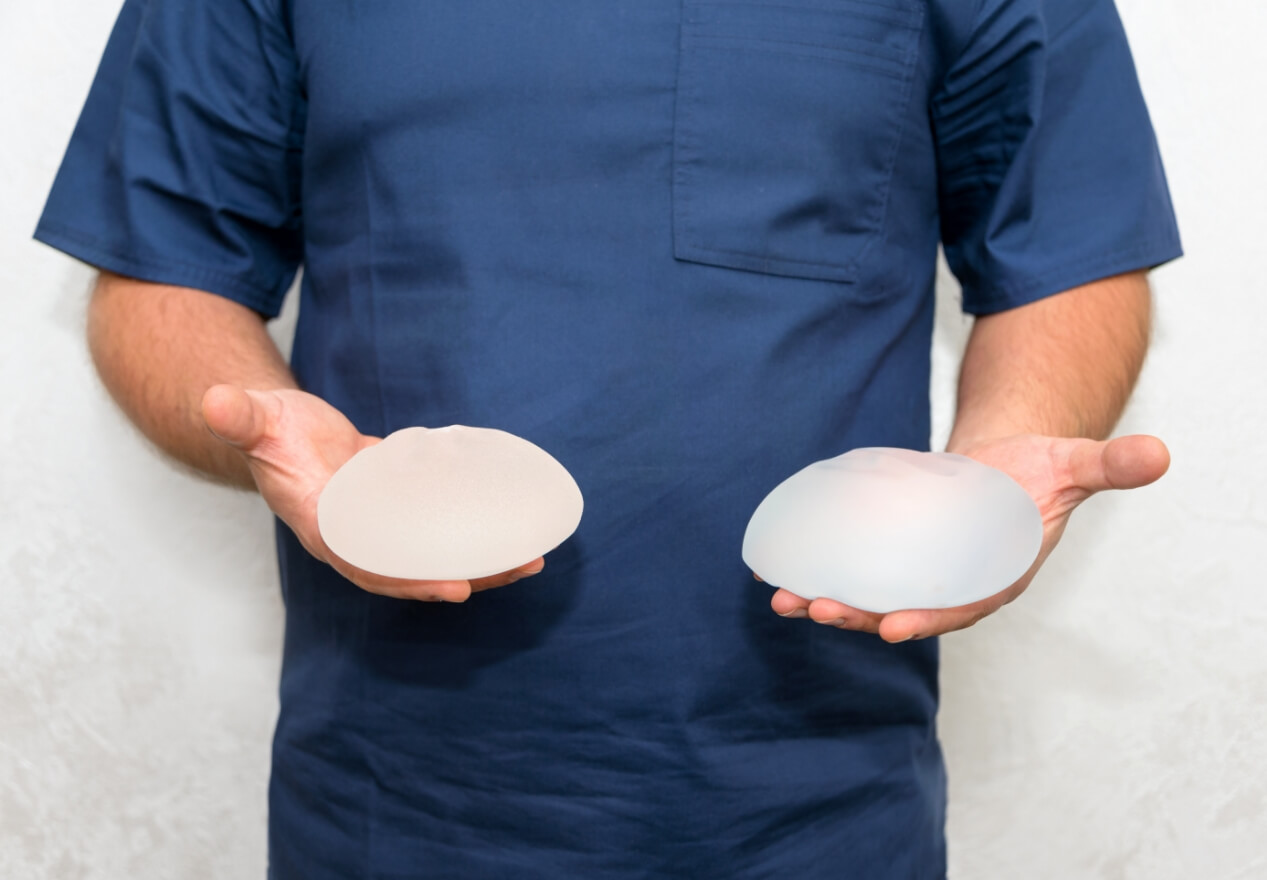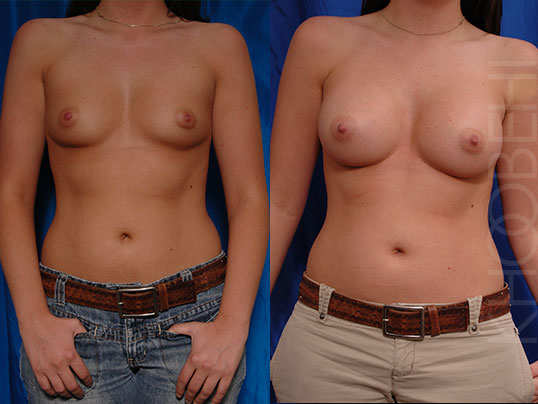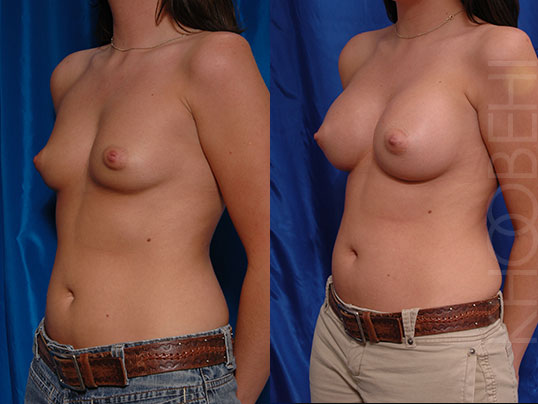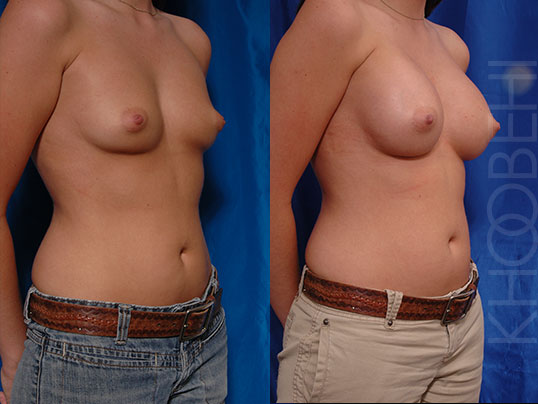Breast Augmentation in New Orleans, LA
Dr. Kamran Khoobehi is a specialist in cosmetic breast surgery and offers breast augmentation for women who desire fuller, shapelier breasts.
Breast Augmentation
Average Cost
$6,200 – $7,400
Recovery Time
1 Week
Average Procedure Time
1-1.5 Hours
We offer breast augmentation surgery with the use of silicone or saline implants to enhance breast shape and size.
Breast augmentation is a popular surgery and creates absolutely gorgeous results that our patients love.
Overview
Breast augmentation is a cosmetic surgery designed to enhance the size, shape, and overall appearance of your breasts. This can be achieved with one of two techniques: implants or autologous fat transfer. Breast implants, filled with either saline or silicone gel, are placed either under the existing breast tissue or under the pectoral muscle to create a fuller, more defined breast contour. Alternatively, fat transfer breast augmentation uses liposuction to harvest fat from areas with excess fat. That fat is then purified and strategically injected into your breasts to achieve natural enhancement. Both methods of breast augmentation are highly customizable, offering results tailored to fit your goals.

Breast Implant Shape
There are many options to consider when determining the type of breast implant to use, as well as the shape and look you want. In fact, choosing the right breast implant shape is one of the most important decisions you’ll make in your breast augmentation journey.
The two primary breast implant options are round or anatomical (teardrop-shaped) implants, each offering different advantages.
Round Implants
- Provide more volume at the top of the breast, known as upper pole fullness
- Create more noticeable cleavage and a rounder, more lifted look
- Are a good choice if you want a more dramatic and noticeable enhancement
Anatomical (Teardrop) Implants
- Designed to mimic the natural slope of your breast
- Fuller at the bottom and tapering toward the top
- A good choice if you want a more subtle, natural appearance
So, what is the best implant shape for you? It depends on several factors, including your body type, the amount of existing breast tissue you have, and your desired aesthetic. When you come in for your breast augmentation consultation with Dr. Khoobehi, he will evaluate your body and discuss your specific aesthetic goals with you, allowing him to create the right treatment plan. He will then help you “try on” different implant options using a 3D imaging system called VECTRA® 3D, which enables real-time visualization of what different implants will look like on your frame based on high-resolution photos and measurements of your chest width and tissue type. Utilizing VECTRA® 3D will help you make a more informed decision when choosing your breast implant type.
VECTRA® 3D Imaging and Breast Implant Planning
VECTRA® 3D Imaging is an advanced technology Dr. Khoobehi uses to help you visualize your breast augmentation results before undergoing surgery. With VECTRA® 3D, you can compare round versus anatomical implants, see how various sizes will look on your body, and preview the subtle differences in contour, projection, and cleavage each option provides. Because of the interactive nature of this approach, you can feel more confident when choosing your breast implants because it’s not just guesswork, but a visual preview of your potential results.
VECTRA® 3D helps you better align your breast augmentation goals with the implant that will provide you with the most satisfying, natural-looking results.
1. 3D Photo Capture
The VECTRA® 3D system takes a series of high-resolution photographs of your chest and torso from multiple angles using a specialized camera.
2. Creation of 3D Model
The software generates a lifelike, three-dimensional model of your body that can be rotated and viewed from all angles.
3. Implant Simulation
Dr. Khoobehi inputs different implant sizes, shapes (round or anatomical), and projections into the VECTRA® 3D system to simulate potential results.
4. Side-by-Side Comparisons
You can then compare the appearance of different implants on your virtual model, including variations in volume and contour.
5. Adjustment & Refinement
Once you and Dr. Khoobehi have refined your choices to the contour you like the most, you can narrow down the implant type you prefer and choose the one that best suits your proportions and desired results.
Breast Implant types

Saline vs. Silicone vs. Fat Transfer
Saline Breast Implants
Saline implants have been available for decades and remain a reliable and affordable choice for breast augmentation. These implants are filled with a sterile saltwater solution, which means that if a leak occurs, your body safely absorbs the saline. They also tend to cost less than silicone implants. However, a potential drawback is that for some patients with little natural breast tissue, the implant edges may be visible or the implant may ripple under the skin. Saline implants are FDA-approved for patients 18 and older.
Silicone Breast Implants
Silicone implants are the most popular breast augmentation option and are often recommended by Dr. Khoobehi for patients seeking enhanced breasts with a natural look and feel. These implants have a silicone shell prefilled with a cohesive silicone gel, available in different sizes, shapes, and textures to fit individual goals. Unlike saline implants, a silicone rupture is more difficult to detect, as the implant doesn’t visibly deflate, and the leak can only be detected with MRI or ultrasound imaging. Silicone implants are FDA-approved for patients 22 and older.
Cleavage Therapy/Fat Transfer
For patients who want fuller breasts without implants, Dr. Khoobehi offers a technique he calls Cleavage Therapy, also known as autologous fat transfer to the breasts. During this procedure, fat is harvested from areas of your body, such as the abdomen, flanks, or thighs, using liposuction. The fat is then purified and carefully and precisely re-injected into the breasts to achieve the desired size and shape. Fat transfer can also enhance cleavage in women whose natural breast spacing limits results from implants alone. In some cases, combining implants with fat grafting provides the most natural-looking and pleasing outcome. Cleavage Therapy can also correct breast asymmetry, rebuild breasts after mastectomy, and improve the softness and fullness of results from a previous breast augmentation.
Manufacturers
There are several FDA-approved breast implant manufacturers:
- Natrelle® by Allergan – silicone and saline-based implants
- Mentor® – silicone and saline-based implants
- Sientra® – silicone-based implants


Breast Implant Profile
Breast implants are also available in different profiles. The profile of your implants determines how much your breasts project forward and how wide the implant appears on your chest in relation to the width of your natural breast base. Silicone implants are prefilled and come in standard profiles, including low, moderate, high, and extra high. Saline implants, on the other hand, can either be prefilled or placed as an empty silicone shell that is then filled with saline solution during surgery to achieve the desired profile.
High-profile implants create more projection but are narrower across the chest, while moderate-profile implants provide less projection with a broader base. Choosing the right profile can feel overwhelming, but Dr. Khoobehi will work closely with you to select the option that best fits your body and aesthetic.
Implant Placement
The two most common placements are on top of the chest muscle (subglandular) or under it (submuscular). Dr. Khoobehi prefers the submuscular approach, as he believes it helps keep the implant in place by considering factors such as implant size, weight, gravity, and time, and provides the implant with the long-term support it needs to stay in position. Placing the implant behind the muscle also provides a softer, more natural look and overall contour.
Incision Type
There are several standard incision approaches for breast implants, including:
- Inframammary incision, which is made along the breast fold where the breast meets the chest wall
- Periareolar incision, which is made along the outside of the areola
- Transaxillary incision, which is made in the folds of the underarm
While the inframammary incision is the most common, Dr. Khoobehi will recommend which incision type is best for your breast augmentation procedure.
During/After Breast Augmentation Surgery
Breast augmentation is an outpatient procedure that typically lasts from one to several hours. It is performed using general anesthesia at an outpatient surgical center. After surgery, you will experience bruising and swelling, and a compression support bra will be worn to provide support to your healing breasts, as well as to help minimize swelling. It is normal to feel tightness around the chest area as your skin adjusts to the new shape of your breasts.
Most patients can resume regular activities within seven days; however, exercise and strenuous activities should be avoided for four to six weeks. It takes approximately six months for the breasts to look, feel, and function normally in regard to softness, sensation, and final positioning on your chest.
Before & After Patient Photos
Expected Cost
Breast augmentation surgery will vary in cost depending on which type of implant is used. The average fee for saline implants is about $4,900 to $6,900. Silicone implants are typically more expensive, starting at about $6,000.
The cost of your breast implants includes the materials and surgeon’s fees, which may be higher depending on your surgeon’s experience and expertise. Dr. Khoobehi is a board-certified plastic surgeon known for his expertise and personalized approach in performing breast augmentation. He works closely with you to develop a treatment plan that is tailored to your specific needs and goals, ensuring that you achieve the best possible outcome.
Breast Augmentation FAQs

Natural Or Artificial?
The best option for your breast augmentation depends on your natural breast makeup and your goals. Patients choosing implants can select between saline and silicone, which each have their own benefits. Fat transfer, on the other hand, uses your own fat, so you avoid the risks of complications associated with implants because no foreign material is introduced into your body. The disadvantage of fat transfer is that your results may not last as long as implants, because some of the transferred fat can be reabsorbed over time or lost due to weight fluctuations. During your consultation, Dr. Khoobehi will review all of your breast augmentation options with you to ensure you achieve the look and feel you desire.
Silicone Risk?
Negative notions about silicone breast implants started back in the early 90s when there were cases of leakage and complications. With today’s advancements in breast implant engineering, the silicone-based implant shells are much more durable and safe, and have been proven so by the FDA. In fact, silicone implants are frequently chosen over saline due to their longevity and more natural feel. The rates of reported complications associated with silicone implants have significantly decreased in the last decade, making them a safe choice for your breast augmentation.
Silicone Leakage?
Modern silicone implants are designed to be strong, durable, and safe. Thanks to advanced technology, even if a rupture occurs, the implant shell usually keeps the silicone gel contained, while the cohesive gel also stays put, both of which help prevent it from leaking into your body. Because silicone breast implant ruptures are not always apparent, an MRI is the most reliable way to detect them. For this reason, it is recommended that patients with silicone implants have an MRI three years after their breast augmentation surgery, and then every two years after the first scan to monitor the condition of the implants.
Implant Or Lift?
Breast augmentation is an aesthetic procedure designed to enlarge the breasts, while a breast lift is designed to tighten loose skin and lift sagging breasts. Both procedures are excellent, but they address different issues. You can choose to combine your breast augmentation with a lift if you wish to address loss of volume and drooping breasts simultaneously, as many women do after significant weight loss or pregnancy and breastfeeding.
Making Your Dream Plastic Surgery Procedure a Reality
Dr. Khoobehi offers financing options with top medical financing companies. We work with you to help ensure you can achieve your desired cosmetic enhancements.
View Financing OptionsCosmetic and Medical Spa Located in the New Orleans Area
You are invited to learn more about the procedures offered by Dr. Khoobehi and to schedule your personal consultation at our plastic surgery office.
Schedule A Consultation
Contact Us
(504) 779-5538KHOOBEHI
3901 Veterans Blvd
Metairie, LA 70002



